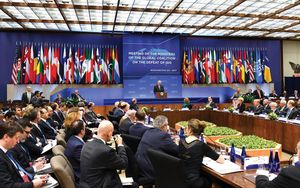On February 1, 2025, President Donald Trump issued new tariffs on imports from Canada, Mexico, and China, heightening trade tensions just days before the policies take effect on February 4. Traders and consumers alike are bracing for the impacts of 25% tariffs on most goods from Canada and Mexico, as well as 10% on imports from China, except for certain Canadian energy resources which will face slightly lower duties.
The move marks another bold assertion of Trump's assertive economic agenda, which he has branded "America First". This initiative appears to address issues beyond mere trade, tackling complex problems involving national security concerns, namely fentanyl smuggling across U.S. borders and irregular migration patterns. "The new tariffs will apply to all imports except Canadian energy resources exports, which will face a 10% tariff instead," White & Case reported.
These tariffs come at the heels of a promise to confront Canada's and Mexico's trading practices deemed harmful to American interests. Unlike established tariff measures, such as those from previous administrations, Trump’s tariffs utilize the powerful International Emergency Economic Powers Act (IEEPA). This act allows the president significant leeway to impose trade restrictions rapidly and with minimal oversight.
According to White & Case, "The tariffs will remain in effect indefinitely, until the president decides to remove them." This statement emphasizes the unpredictability associated with the tariffs, especially with the prospect of retaliation from Canada, Mexico, and China looming on the horizon. "All three countries have signaled their intention to retaliate," the report highlights, setting up potential escalations likely to rock global markets.
The executive orders highlight how past relationships with trading partners could be strained even more. The imposed tariffs will primarily affect goods entered for consumption after 12:01 AM EST on February 4, 2025, which means significant disruptions are anticipated across various sectors, especially those relying on cross-border supply chains.
Goods already en route to the U.S. prior to the issuance of tariffs on February 1, 2025, will be exempt from these new measures, alleviating some immediate pressures for businesses and consumers who typically face unforeseen costs during such swift tariff implementations.
The repercussions of these tariffs may extend beyond mere ticket price hikes for consumers; expectations suggest economic fallout for the American economy, especially as the tariffs on Canada and Mexico are set against the backdrop of the intertwined economy of the U.S. and its North American neighbors, impacting nearly 30% of the U.S.’s total trade. Unconfirmed reports suggest expectations for energy tariffs maybe doubling, as Trump hinted at increasing tariffs on oil and gas imports from Canada shortly after the initial wave takes effect.
Interestingly, should retaliations commence, it would not be surprising to see even higher tariffs surface resulting from this tit-for-tat strategy. Experts speculate, based on previous encounters, tariffs are more than just simple trade negotiation tactics; they now serve as tools wielded to pressure adversaries on multiple fronts.
For other nations, Trump’s approach poses new questions not only for immediate trade tactics but for long-term geopolitical relationships. The lack of clarity surrounding the specific list of Harmonized Tariff Schedule (HTSUS) codes and how they will impact specific merchandise leaves many businesses uncertain of how best to proceed. The precise ramifications on consumer goods and prices remain to be seen, complicity for businesses to navigate changes forced upon them seemingly overnight.
While the tariffs signify aggressive moves aimed at protecting national interests, they simultaneously raise questions about risks to U.S. economic stability with the new trade policies. Trump’s willingness to invoke the IEEPA also suggests he views any opposition to his plans as having potentially serious repercussions. Conversely, these strategies may leave him susceptible to accusations of unreasoned brinksmanship.
Analysts predict turbulence across financial markets as companies adjust to these new tariffs, with potential hikes expected across the spectrum of goods from electronics to clothing, yet the exact impact will only emerge as the legislation fully takes effect. With these tariffs enforced, businesses are advised to brace for more than just rising costs—it's about strategizing their operations amid rocked relationships with neighboring countries.
This independently crafted regime of U.S. tariffs sets no precedent; it is the continuous actions toward restructuring international agreements and trade relations, pointing to yet another wave of competing national strategies the world has witnessed.
While much remains uncertain, one thing is clear: President Trump's tariff decisions have set the stage for America's trade future, demanding adaptability among importers and heightened scrutiny from trading partners watching the U.S. for any unanticipated moves. Navigators on this patchwork economic seas need to stay alert as other nations react, strategize, and reflect on how to respond to the changing dynamics shifting swiftly at the helm of U.S. foreign trade policy.



